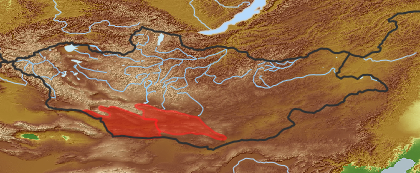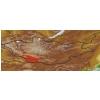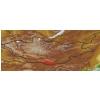| Class: | angiosperms |
| Order: | Sapindales |
| Family: | Nitrariaceae |
| Genus: | Nitraria |
| Scientific name: | Nitraria sphaerocarpa Maxim. |
| Name acc. to: | Gubanov 1996 |
| Herbar: | list records |
| Link to Flora of China: | http://www.efloras.org/browse.aspx?flora_id=2&name_str=Nitraria+sphaerocarpa |
| open map in a new window |  |
| Habitat: | Sanded pebble and stony deserts, thin sands, sanded tailings of mountains and hills (Grubov 2001). |
| Habit (i)general appearance of a plant | |
| Growth form: (i)Herb, shrub, tree or climber. | shrub, subshrub or semishrub (i)Shrub, multi-stemmed, mostly (0.2) 0.5 - 5 m high, shoots woody up to the tip
example: Caragana leucophloea   inherited by family Nitrariaceae: shrub, subshrub or semishrub inherited by family Nitrariaceae: shrub, subshrub or semishrub
|
| Size of plant: (i)Attention: use flowering or fruiting specimens to assess plant height (many biennial plants possess only a basal rosette in the first year). | from 250 mm to 600 mm
|
| Parasite status: (i)Is the plant a half- or full parasite? | no parasite/saprophyte (i)Plant fully autonomous, leaves with chlorophyll
example: Most plants, Ranunculus  inherited by family Nitrariaceae: no parasite/saprophyte inherited by family Nitrariaceae: no parasite/saprophyte
|
| Water or terrestrial plant: (i)Where do the plants grow? | terrestrial (i)Plant grows on dry land
example: Orostachys spinosa  inherited by family Nitrariaceae: terrestrial inherited by family Nitrariaceae: terrestrial
|
| Leaf (i)expanded, usually photosynthetic organ of a plant (including phylloclades) | |
| Leaf development: (i)Structure and development of leaves. | with green leaves (i)Plant with green leaves  inherited by family Nitrariaceae: with green leaves inherited by family Nitrariaceae: with green leaves
fleshy leaf (i)Leaves more or less thick, juicy, terete or flat
example: Crassulaceae  inherited by family Nitrariaceae: fleshy leaf inherited by family Nitrariaceae: fleshy leaf
|
| Leaf arrangement: (i)Arrangement of leaves at the stem. | whorled or fascicled (i)Three or more leaves per node or leaves crowded.
example: Galium, Nitraria   inherited by family Nitrariaceae: whorled or fascicled inherited by family Nitrariaceae: whorled or fascicled
others ? (i)Not as above (soll gelöscht werden)
|
| Simple or divided leaves: (i)Are the leaves simple or completely divided in several parts? Blade of the leaf entire or (more or less) deeply dissected. Attention: There are various appearances of the leaf margin (from entire to toothed and lobed). Here, we ignore this and ask only for dissections that separate the leaf for more than one third of its length or width, whatever is smaller. Sometimes, it is difficult to tell apart compound leaves from a shoot system with simple leaves: look for stipulae and/or axillary buds at the ground of the leaves: if only some possess these structures, the others are most likely leaflets of a compound leaf. | simple (i)Non-divided leaf, but margin may be incised nearly to the ground   inherited by family Nitrariaceae: simple inherited by family Nitrariaceae: simple
|
| Shape of blade: (i)Easy for simple leaves. In compound leaves use the general shape of leaflet. Always check the ground for largest leaves of a plant. To be worked out: how to handle pinnate leaves? | linear incl.grasslike or oblong (i)Leaves more than two times longer than broad with more or less parallel margins; see character: stipule for ligula
example: Dracocephalum ruyschiana, Poaceae, Scutellaria scordifolia, Pinus 
|
| Length of leaves: (i)How long is the leaf, be carefull in compound leaves, measure the complete leaf. | from 6 mm to 10 mm
from 11 mm to 20 mm
from 21 mm to 50 mm
|
| Leaf margin: (i)Structure of leaf margin (or that of a leaflet in case of compound leaves). Attention: Here we ask for the leaf margin, defined as all those dissections that separate the leaf for less than one third of its length or width, whatever is smaller. To be worked out: how to handle margin of pinnate leaves? | entire (i)Plain margin, not toothed
example: Iris   inherited by family Nitrariaceae: entire inherited by family Nitrariaceae: entire
|
| Petiole: (i)Leaf divided into stalk (petiole) and blade. | without (i)Leaves without petiole (stalk), sessile
example: Poaceae, Iris 
|
| Stipule: (i)Leaflets at the base of the petiole, these are smaller and of different shape. | pair (i)A pair of free stipulae
example: Lathyrus, Trifolium   inherited by family Nitrariaceae: pair inherited by family Nitrariaceae: pair
|
| Flower (i)reproductive portion of the plant, consisting of sepals, petals, stamens, and pistils | |
| Flower appearance and pollination: (i)General appearance of the flower. | attractive, animal-pollinated (i)attractive and coloured flowers, mostly large, attracting surely animals
example: Trollius, Rosa, Chamaerhodos  inherited by family Nitrariaceae: attractive, animal-pollinated inherited by family Nitrariaceae: attractive, animal-pollinated
|
| Flower colour: (i)Attention: assess colour of the most colourful parts of the flower, but not of the stamens; be aware of single plants with a mutation (mostly white) on flower colour. | greenish (i)petals absent or not distinctly different from colours of leaves, only stigmas (white) or anthers (yellow) may differ in color
example: Chenopodium, Triglochin  inherited by family Nitrariaceae: greenish inherited by family Nitrariaceae: greenish
white (i)Most plants of the population white
example: Pleurospermum, Maianthemum  inherited by family Nitrariaceae: white inherited by family Nitrariaceae: white
yellow to orange (i)Pale to golden yellow
example: Ranunculus, Crepis  inherited by family Nitrariaceae: yellow to orange inherited by family Nitrariaceae: yellow to orange
|
| Perianth arrangement: (i)Attention: in some plants, flowers may be dimorphic in different ways (dioecious or gynodioecious). If flowers vary, record the characters of the most showy flowers. | double, different (i)Two types of perianth leaves, differently coloured (sepals: outer periant leaves, usually greenish, and petals: inner perianth leaves, usually coloured)
example: Parnassia    inherited by family Nitrariaceae: double, different inherited by family Nitrariaceae: double, different
|
| Diameter of flower: (i)Diameter of flower or flower head. | from 5 mm to 10 mm (i)
example: Stellaria
|
| Flower symmetry: (i)Symmetry of the perianth leaves. Attention: to assess this character, look on sepals, petals and stamens, but neglect carpels and ovary. | radiary, regular (actinomorphic) (i)More than two axis of symmetry
example: Saxifraga: 5; Iris: 3   inherited by family Nitrariaceae: radiary, regular (actinomorphic) inherited by family Nitrariaceae: radiary, regular (actinomorphic)
|
| Flower form: (i)common forms of flowers ? Veronica | simple (flat) - Do not confuse with inflorescences as in some Asteraceae (i)Petals spread out, flower appearing flat
example: Mollugo, Trientalis, Pulsatilla, Saxifraga   inherited by family Nitrariaceae: simple (flat) - Do not confuse with inflorescences as in some Asteraceae inherited by family Nitrariaceae: simple (flat) - Do not confuse with inflorescences as in some Asteraceae
|
| Sepal number: (i)Number of sepal leaves (outer perianth leaves, calyx leaves, mostly greenish). Attention, this character applies only for flowers separated in sepals and petals, thus excluding most monocots. Be aware of the bracts (involucral leaves) of Asteraceae flowerheads, do not qualify these as sepals! Be also aware in Rosaceae is often an epicalyx developed, in this case count all parts. | 5 (i)
example: Polemonium  inherited by family Nitrariaceae: 5 inherited by family Nitrariaceae: 5
|
| Petal / Tepal number: (i)Number of petal leaves (inner perianth leaves, usually coloured). | 5 (i)
example: Potentilla  inherited by family Nitrariaceae: 5 inherited by family Nitrariaceae: 5
|
| Petal / Tepal fusion: (i)To which degree are the petal leaves connected? Petals sympetalous. | free (i)all petal leaves separate from each other
example: Anthriscus  inherited by family Nitrariaceae: free inherited by family Nitrariaceae: free
|
| Spur: (i)A hollow, slender, sac-like appendage of the perianth leaves, storing nectar. | no spur (i)Flower without appendage
example: Peganum  inherited by family Nitrariaceae: no spur inherited by family Nitrariaceae: no spur
|
| Stamen number: (i)Attention: We ask for the reproductive organs of the flower dispersing pollen. Count only fully fertile stamens, not staminodia (e.g. Parnassia). | 10 (i)
example: Silene  inherited by family Nitrariaceae: 10 inherited by family Nitrariaceae: 10
> 10 (i)
example: Nymphaea, Callianthemum, Rosa  inherited by family Nitrariaceae: > 10 inherited by family Nitrariaceae: > 10
|
| Stamen fusion: (i)To which degree are the stamens fused? Attention: Whereas the pollen sacs itself are often free., their stalks (filaments) may be fused. Here, we count them as fused if they are together over at least one thirth of their length. | free (i)Stamens with separate bases
example: Malus  inherited by family Nitrariaceae: free inherited by family Nitrariaceae: free
|
| Style number: (i)Portion of the pistil connecting the stigma to the ovary. | 1  inherited by family Nitrariaceae: 1 inherited by family Nitrariaceae: 1
|
| Ovary position: (i)For entirely or partly fused carpels, describe their position in relation to the insertion point of perianth leaves (best done by doing a longitudinal section of a flower). | superior (hypogynous) (i)Base of carpels attached above insertion point of perianth leaves, carpels free or fused
example: Delphinium, Anemone    inherited by family Nitrariaceae: superior (hypogynous) inherited by family Nitrariaceae: superior (hypogynous)
|
| Sex: (i)Distribution of male and female organs among flowers, only most commonly cases. | bisexual, hermaphrodite (i)All or nearly all flowers of a plant with male and female parts
example: Haplophyllum, Chenopodium  inherited by family Nitrariaceae: bisexual, hermaphrodite inherited by family Nitrariaceae: bisexual, hermaphrodite
|
| Inflorescence (i)flowering part of a plant, describes the arrangement of the flowers on the flowering axis | |
| Inflorescence: (i)Structure of the inflorescence. | Flowers in inflorescence (i)No solitary flowers
|
| Inflorescence type: (i)Types of inflorescence. Attention: We here ask for the botanical nomenclature of inflorescences, which is sufficiently complicated. Tick only, if you are certain, or tick all inflorescence types that appear similar of these of the plant in question. | cyme (i)A branched inflorescence, where the main shoot soon ends in a flower, being overtopped by one ore more shoots; attention: the flowers are often very crowded and the type difficult to identify (Lamiaceae)
example: Lamiaceae, Caryophyllaceae, Mollugo cerviana, Panzerina 
|
| Fruit (i)the seed bearing organ, with or without adnate parts; a ripened ovary and any other structures which are attached and ripen with it. Aggregate fruits are handled like simple fruits for determination. | |
| Consistency: (i)Fleshy fruits or dry fruits, see dispersal adaptations for further classification. | dry (i)With a dry outer shell, no fleshy parts, but seed (embryo) could be edible
|
| Type of fruit: (i)Common fruit types (including pseudocarp). | Indehiscent fruits  inherited by family Nitrariaceae: Indehiscent fruits inherited by family Nitrariaceae: Indehiscent fruits
Solitary fruits (i)     inherited by family Nitrariaceae: Solitary fruits inherited by family Nitrariaceae: Solitary fruits
drupe (stone fruit) (i)Fleshy, indehiscent fruit with a single, hard stone inside
example: Plum, cherry   inherited by family Nitrariaceae: drupe (stone fruit) inherited by family Nitrariaceae: drupe (stone fruit)
|
| Size of fruit: (i)Size of the fruit including appendage. | from 5 mm to 10 mm (i)
example: Silene: small capsule opening with teeth
|
| Seed number: (i)Estimate the number of seeds per fruit, if recognizable seeds are in the fruit (in rare cases a fruit may contain one seeded nuts: rose hip, carex). | 1 (i)A single seed (stone) or seed and fruit wall tightly connected
example: Prunus, Amygdalus: drupe  inherited by family Nitrariaceae: 1 inherited by family Nitrariaceae: 1
|
| Hairs | |
| Hairs: (i)Appearance, structure, coverage of hairs on plant. | Hairs on fruits
|
| Shoot/Stem (i)a young stem or branch | |
| Spines, thorns or prickles: (i)Shoot with conspicuous spines, thorns or prickles. | spines or thornes (i)Sharp pointed woody structure originating from the plant (thornes derived from a reduced branch, spines from leaves)
example: Prunus spinosa no in Mongolia  inherited by genus Nitraria: spines or thornes inherited by genus Nitraria: spines or thornes
|
| Root / shoot below ground (i)plant part below ground (in most cases), including below ground shoots, without leaves | |
| Root type: (i)Organisation of the roots. | allorhizous (i)Plant with a conspicuous tap root, one larger tap root with side roots
example: Dicotyledonae  inherited by order Sapindales: allorhizous inherited by order Sapindales: allorhizous
|
| Distribution (i)region where the plant is likely to be found | |
| Distribution (Veg. Zones): (i)acc. to Grubov 1952 | Gobi-Altai (i)In distribution data often named as '13' 
Transaltai Gobi (i)In distribution data often named as '15' 
Alashan Gobi (i)In distribution data often named as '16' 
acc. to: Gubanov 1996 |
| Plant Status | |
| Endemism: | subendemit: China
acc. to: Gubanov 1996 |